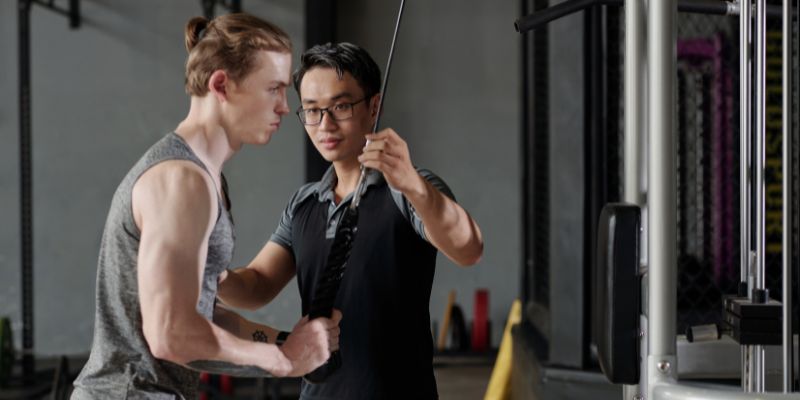One excellent workout for developing better shoulders is the cable lateral raise. It works the deltoid muscles, which are crucial for shoulder stability and strength. Unlike free weights, this exercise offers special resistance and continuous tension throughout the movement. Whether you have experience or not, cable lateral raises will improve your shoulder workouts.
Safety and effectiveness depend on awareness of the correct form. Bad technique could strain your shoulders and lower your benefits. This guide demonstrates step-by-step cable lateral raises and addresses variants, common mistakes, and advantages. Including this movement in your routine will show clear changes over time. Follow along to discover how to maximize your shoulder improvements with this basic yet effective workout.

Benefits of Cable Lateral Raises
There are many benefits of cable lateral raises:
- Builds Stronger Deltoid Muscles: Usually aiming at the lateral head of the deltoid muscles, cable lateral raises your shoulders to look broad and rounded only because of these muscles. Good deltoids are vital not only for appearance but also for a variety of upper body motions.
- Provides Constant Resistance: Unlike dumbbells, which depend on gravity, cables create continuous tension throughout the range of motion. From start to finish, this continuous resistance maintains your muscles active, improving activation and muscle development.
- Reduces Risk of Injury: Cable lateral raises strengthen the deltoids and increase shoulder stability, therefore shielding your shoulder joints from pressure and damage. Stronger shoulder muscles also assist the rotator cuff, therefore lowering the likelihood of overuse problems or tears.
- Improves Aesthetic Appeal: Cable lateral lifts are great for developing balanced, well-developed shoulders. Strong deltoids give your upper body a more toned and defined appearance and aid in producing a more symmetrical figure.
Step-by-Step Guide to Performing Cable Lateral Raises
Here is a step-by-step guide on performing cable lateral raises:
- Step 1: Set Up the Cable Machine: Attach a single handle first to the cable machine's low pulley. Be sure the cable is well attached to prevent mishaps. Starting with a modest weight to practice the movement, change the weight to a reasonable level. As you get more at ease with the workout, you may always add weight.
- Step 2: Position Yourself: Faced away from the pulley, stand sideways to the cable machine. Space your feet shoulder-width apart to guarantee balance. To keep a good posture all through the exercise, slightly bend your knees. Your body should still be in line with the machine while the hand furthest from the pulley holds the cable handle.
- Step 3: Grip and Stance: Grab the handle using a neutral grip, that is, where your palm faces your body. Keep your arm not locked but straight and somewhat relaxed. For further support, position your opposite hand on the machine or your hip. It will keep you from swinging your body while allowing you to keep balance and concentrate on the shoulder action.
- Step 4: Lift the Cable: Keeping your arm straight and with a minor elbow bend, slowly raise it out to the side. Raising the handle till your arm reaches shoulder height will help. Throughout the exercise, keep your palm facing down. It guarantees that the deltoid muscle stays the major emphasis instead of depending on other arm muscles.
- Step 5: Control the Movement: Slowly and under control, lower your arm back to the starting point. Avoid letting the cord rapidly lower your arm. Resisting the pull of the cable more effectively activates the muscles, therefore promoting muscle development and control.
- Step 6: Repeat: Desire for 10 to 12 repetitions per set and perform the necessary amount of times. Finish a set with one arm, then move to the other arm. For the most benefit, try three to four sets per arm. To guarantee complete muscular involvement and prevent any jerking actions, keep the movement gradual and under control.

Common Mistakes to Avoid
Below are some of the common mistakes you should avoid when doing cable lateral raises:
- Using Too Much Weight: Too heavy lifting could damage your form and result in injury. Starting smaller weights lets you concentrate on perfecting the technique.
- Swinging the Arm: Avoid raising the cable using momentum. Swinging your arm to finish the movement lowers muscle involvement and lessens the exercise's effectiveness. Concentrate on modest, under-control motions to guarantee complete activation of your deltoid muscles throughout the exercise.
- Lifting Too High: Raising your arm over shoulder height can strain your shoulder joint excessively. Keep your arm level with your shoulder to maintain correct form and avoid overextension.
- Neglecting the Negative Phase: Just as vital as lifting is the lowering component of the exercise. Slowing down the cable helps the muscle to grow by increasing tension. Steer clear or let the wire rapidly drag your arm down. Control the fall to maximize every rep's performance.
Variations of Cable Lateral Raises
Variations of Cable Lateral Raises are as follows:
- Two-Arm Cable Lateral Raise: Do this variant with both arms at once. It gives both shoulders balanced opposition and saves time.
- Behind-the-Back Cable Lateral Raise: Arrange the cord behind your back at an unusual angle. It will vary the stretch on the deltoid muscles.
- Single-Leg Cable Lateral Raise: Work the workout while balancing on one leg. It works your core muscles and presents a stability test.
- Seated Cable Lateral Raise: Perform the exercise seated on a bench. It removes momentum and forces your shoulders to work more deliberately.
Conclusion:
Ultimately, a great workout for strengthening, more solid shoulders are cable lateral raises. They increase shoulder mobility, focus the deltoid muscles and lower injury risk. Incorporating the correct form and progressively raising resistance will help you attain both aesthetic attractiveness and functional strength. Keep in mind to prevent typical errors such as swinging the arm or using excessive weight. Cable lateral raises can greatly improve your shoulder exercises and general upper body strength with regularity and attention to precision. This workout will help your shoulder health and attractiveness over time, regardless of your level of experience or ability.













